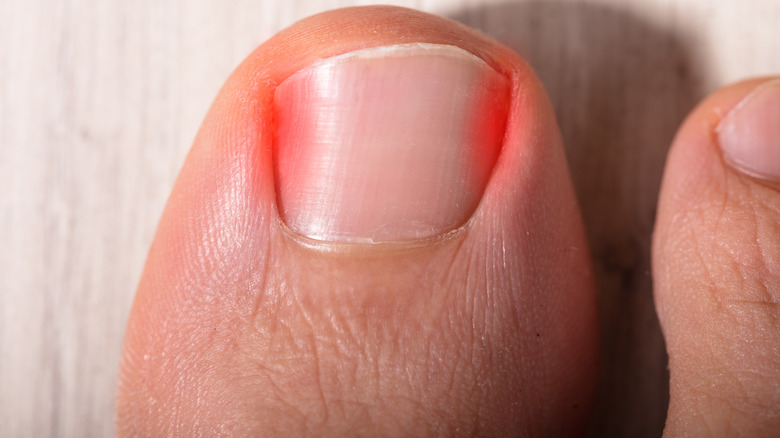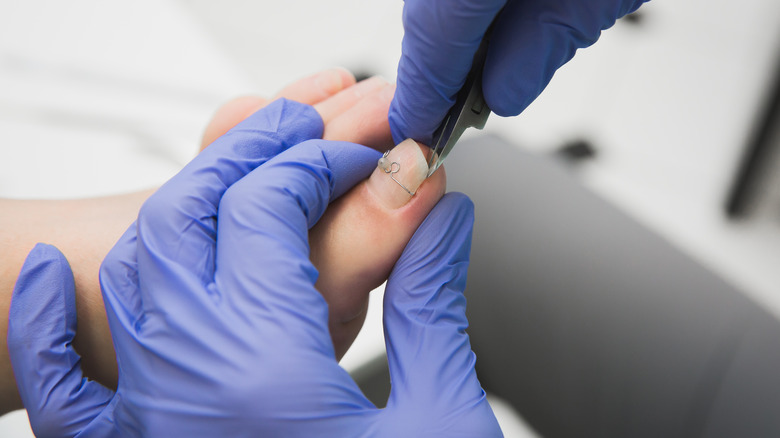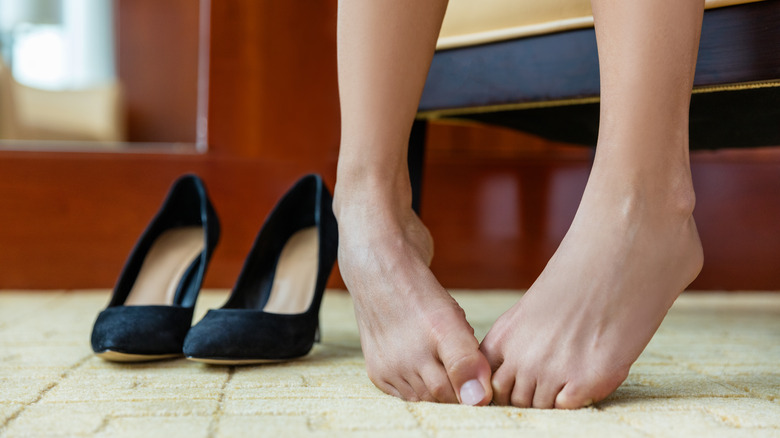This Is What Really Causes Ingrown Nails
If you've ever experienced an ingrown nail, you know how painful, sensitive, and tear-inducing they can be. Whether located on your fingers or toes, symptoms most often include redness, swelling, pain, and oozing. This condition may be easily confused with a nail infection, but both conditions are different. Ingrown nails are caused by the nail growing into the sides of the skin surrounding the nail, causing pressure and other potential skin complications, according to Healthline.
However, while these two conditions are different, an ingrown nail can be the cause of a painful nail infection, also known as paronychia, as noted by the Cleveland Clinic. It can be helpful to note that ingrown nails predominantly affect toenails more often than fingernails and toenail infections caused by ingrown nails can be a great source of pain. But health experts suggest there are key risk factors when it comes to ingrown nails. So what exactly causes them and how, if at all, can they be prevented?
Improper nail cutting
One of the most common ways that ingrown nails happen is by cutting your nails improperly (via Avita Health). Specifically, you increase your risk when you cut the nail straight across which removes the natural curve of the nail. It can also increase the risk of the sharp edges of the nail pressing into the soft skin on the side of your nails. Additionally, pedicures performed too aggressively can increase your risk.
Healthline recommends first using the proper nail-cutting tools, like nail clippers. It's important to avoid using regular scissors or knives to get the job done. It's also recommended to cut the sides of the nail first and then the tip after, totaling three cuts. Additionally, you may need stronger nail clippers for your toes than your fingers, which can also prevent bacterial transfer between the toes on your hands and feet. Be sure to cut your nails every six to eight weeks in order to reduce your risk even further.
Improper footwear
Wearing footwear is a necessity for protecting your feet, but wearing shoes that are too tight can press your nails into the surrounding skin and result in an infection. According to WebMD, wearing ill-fitting footwear that is too tight or too small, including tight hosiery and socks, can increase the likelihood of experiencing an ingrown nail. When shopping for shoes, make certain that there is enough room to comfortably wiggle your toes, especially with high heels that put extra pressure on the front of the foot. The same goes for gloves that are too tight which can squish fingernails, thus putting them at risk of becoming ingrown.
According to The Podiatry Center, choosing comfort over fashion may not be trendy, but it's important for foot health. Opting for athletic shoes that allow the foot ample room, provide support, and allow your feet to breathe are the best option when it comes to ingrown toenail prevention.
Injuries
Who hasn't dropped something on their foot before? It's not only extremely painful, but causing sudden injury to nails can make them more likely to split, crack, and ultimately become ingrown or infected (via Mayo Clinic). And it's not just the accidental injury to nails, like that painfully annoying time you stubbed your toe, that can increase your risk. Ongoing trauma, like the kind that happens when you play sports or perform certain activities, can cause nails to become ingrown. Consider the ballet dancers who go on pointe and direct pressure on their toes, or runners who train over long distances. Soccer players and football kickers can also become prone to ingrown nails because of the pressure particularly on their big toes when they repeatedly kick a ball, Healthline reports.
Sports Medicine Today suggests there are ways to promote great foot health and heal ingrown toes as an athlete, such as soaking the feet in warm water and epsom salt, avoiding picking the nails, and seeking medical attention if the pain is severe or it looks like the nail is infected.




